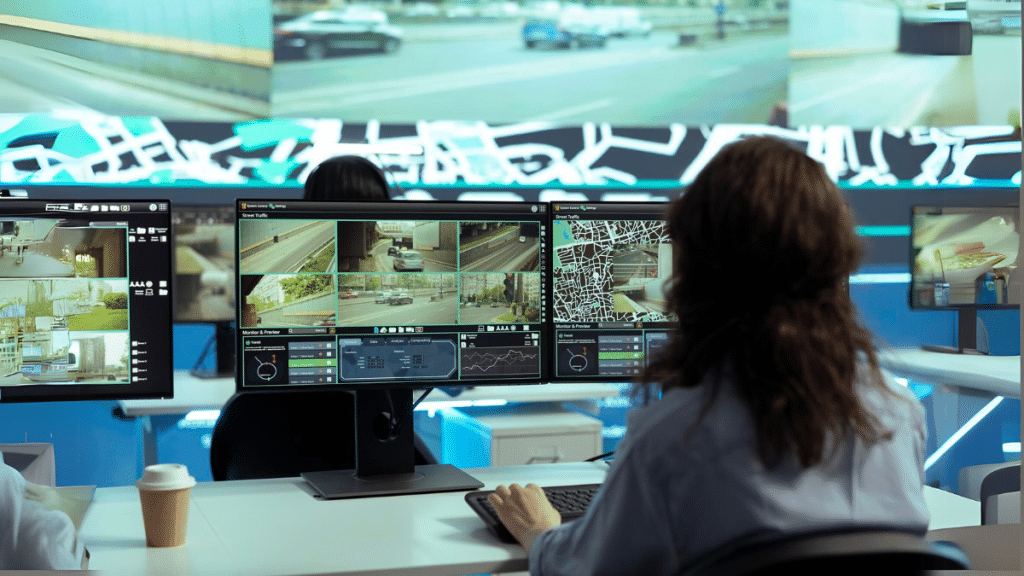Most of us don’t even notice security cameras anymore. They’re on street poles, outside shops, at traffic lights, and in car parks. They’re just part of the background now. But here’s something you might not know: many of those cameras aren’t just sitting there recording endlessly waiting for an incident to happen. Across cities, urban planners are quietly weaving these cameras into what’s called a “smart city grid.”
Now, before you picture a futuristic, sci-fi movie scene, let’s break it down. A smart city is just a regular city that’s using technology to run better—whether that means managing traffic, lighting, waste collection, or, in this case, public safety. And that’s where security cameras come in.
What’s changing is not just where the cameras are, but what they can do. Many of them are now AI powered security cameras—and no, that doesn’t mean they’re spying on you 24/7 like a robot overlord. It just means they’re getting smarter at recognising real threats (like an abandoned bag or a person loitering after hours) and filtering out the non-issues (like someone walking their dog).
If you are looking for advanced security cameras for yourself and your property, you will need to learn more about the installation process and pricing by security technicians.But first, let’s talk about why these smart security cameras are popping up in more places—and why city planners are being pretty quiet about the whole thing.
The Technological Advancements of Security Cameras
Not long ago, security cameras were mostly used as “after the fact” tools. Something happens—like a theft, accident, or vandalism—and the footage is reviewed later. That’s still part of the picture, but smart cameras are doing more.
These new-age cameras can recognise unusual activity in real time. They can send alerts, trigger alarms, or even communicate with nearby systems—like traffic lights or street lights—to respond accordingly. A camera outside a train station that notices someone pacing around suspiciously late at night might trigger extra lighting or alert nearby patrols.
You’d be surprised at how these cameras now work together. They’re not just filming—they’re connected, which means they’re helping build smarter responses to real-world situations. And that’s where the idea of the “smart grid” comes in.
Why Are Urban Planners Doing This Quietly?
There’s a good reason city officials and planners aren’t making front-page announcements about this kind of rollout: people are sensitive about being watched. And rightly so.
Surveillance brings up questions about privacy, consent, and trust. But most of these integrations aren’t about watching individuals—they’re about managing the city more efficiently.
Instead of making a big deal about adding more cameras, urban planners are embedding them into other infrastructure updates. A new traffic light? Might come with a smart camera built in. That fresh set of street lights in your suburb? Probably has sensors and a camera installed too.
It’s happening gradually, and in ways that blend in with city life. And to be honest, it’s working.
Using The Camera as a Utility
What’s interesting is that security cameras in smart city grids are being treated more like utilities now—just like street lights or storm drains. They’re part of the city’s ability to function well.
Here are just a few things they’re being used for beyond security:
- Traffic flow management: Cameras detect congestion and feed that info to digital signs or traffic control centres.
- Smart lighting: If a street is empty, lights dim to save energy. If motion is detected, they brighten automatically.
- Emergency response: In the event of an accident or medical emergency, smart systems can guide responders to the exact location faster.
- Urban planning: Footage and data help planners understand how people move through parks, squares, and public spaces.
What This Means for Residents and Business Owners
If you live in a growing city, chances are you’re already part of a smart grid—you just might not know it yet.
For residents, it means your streets are being designed to be safer, more responsive, and better managed. For businesses, especially those open late or in high-foot-traffic zones, this kind of technology can be a huge boost.
It doesn’t replace traditional security measures, but it adds another layer that works quietly in the background.
If you’re a business owner, especially in retail or hospitality, it might be worth looking into how your own security systems can tie into the local smart network. Want to learn more about how AI-powered cameras work in businesses? There’s a growing amount of info available for business owners considering an upgrade.
As residents, we should definitely be asking questions—especially about privacy. But we should also understand the benefits. A smarter city, if done right, can mean a safer, smoother experience for everyone who lives, works, and visits there.
So the next time you spot a camera on a street pole or traffic light, remember—it might just be helping the city run a little better, and not just watching your every move.
